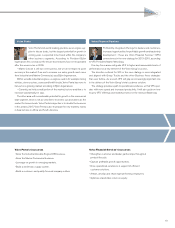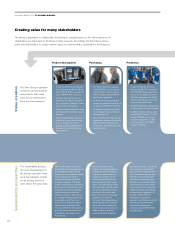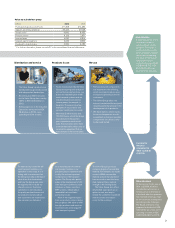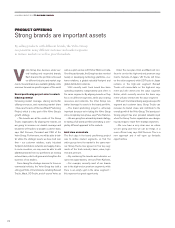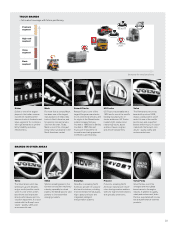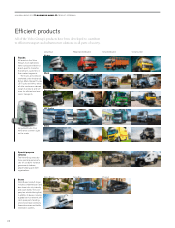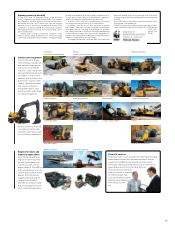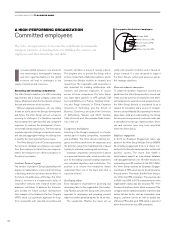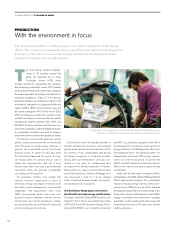Volvo 2012 Annual Report Download - page 30
Download and view the complete annual report
Please find page 30 of the 2012 Volvo annual report below. You can navigate through the pages in the report by either clicking on the pages listed below, or by using the keyword search tool below to find specific information within the annual report.
A GLOBAL GROUP 2012 BUSINESS MODEL PRODUCT OFFERING
It is critical for the Volvo Group's future success to continue to be innovative and develop
technologies, which can be converted into financially viable products and services.
limate change is one of the greatest
challenges faced by mankind.
Research shows that transport is
responsible for approximately 13%
of the total greenhouse gas emissions caused by
humans. As one of the world’s largest manufac-
turers of commercial vehicles the Volvo Group
works to reduce CO2 emissions from the use of
its products.
Three areas of focus
The Group's product development is affected by
the cost of, access to and availability of fuel, as
well as legislation in the environmental area.
Therefore, the Volvo Group focuses its research
and development on the development of ener-
gy-efficient drivelines, hybrid and electric drive-
lines and vehicles that can be operated on
renewable fuels.
The Volvo Group also participates in public
and private partnerships to develop sustainable
and efficient transport systems such as Bus
Rapid Transport System (BRT) and Intelligent
Transport Solutions (ITS).
Energy-efficient drivelines
The Group's products have the largest impact on
the environment in the usage phase. Therefore
the Group has a life-cycle perspective and con-
sider the environmental impact from the prod-
ucts, from them being developed all the way to
them being phased out and recycled. Since
approximately 90% of the environmental impact
results from the use of the products, the Group's
main focus is on reducing fuel consumption, CO2
emissions and other emissions to the air. The
basic principle is that each new product shall
have less impact on the environment than the
product it replaces.
The Volvo Group estimates the fuel-saving
potential for a standard truck will be 15% in
2020 compared with fuel consumption in 2005.
New technology can lead to even more signifi-
cant savings. For instance, the use of a hybrid
driveline may improve fuel savings by up to 39%
in certain bus operations.
39% makes this bus a commercially viable option.
In 2011 Volvo Trucks commenced sales of
hybrid trucks, under the name Volvo FE Hybrid, to
customers in selected European markets. With a
plug-in solution, the fuel saving potential of a Volvo
FE Hybrid is up to 30% in refuse applications. In
distribution applications the saving is 15–20%.
Renewable and alternative fuels
Carbon dioxide neutral vehicles are powered by
fuel produced from renewable raw materials
such as biomass. Reducing dependency on fossil
fuels such as oil, coal and natural gas by increas-
ing the use of renewable fuels makes business
and environmental sense. The Volvo Group’s
research on renewable fuels is mainly focused
on Methane Diesel and DME (dimethyl ether).
Joint DME project
DME is a potential alternative to fossil fuel; it is
energy-efficient and has a proven lower environ-
mental impact. Estimates show that by replacing
conventional diesel with Bio-DME carbon dioxide
emissions will be cut by 95%.
The BioDME project is a joint venture with,
among others, the EU and the Swedish Energy
Agency. The aim is to involve the entire chain;
from production of DME from biomass, distribu-
tion to DME used as vehicle fuel.
Combining methane and diesel
The benefit of methane diesel technology is
that methane fuel is already available as a fuel
for vehicles. Volvo FM and Volvo FL/FE are
available in methane diesel versions. The trucks
are powered by up to 75% gas and therefore
the CO2-emissions are reduced. Volvo Trucks is
the first manufacturer in Europe that sells
gas-powered trucks for long-haul operations.
Environmentally enhanced products
C
Energy-efficient
drivelines
Renewable
fuels
Hybrid and
electric drivelines
Three areas of focus
Hybrid and electric drivelines
Hybrid technology is one of the most promising
and competitive technologies for commercial
vehicles, because of its potential for saving fuel,
hybrid technology means lower operating costs
for customers while at the same time significantly
reducing environmental impact.
The most appropriate vehicles for hybrid
drivelines are those operating in continuous
stop-go conditions, such as city buses and
refuse or distribution trucks.
The Volvo Group’s I-SAM concept consists of an
electric motor and a diesel engine working in par-
allel, whereby each of them can be used where
they are most effective. Production of the Volvo
Hybrid city bus and the Volvo Hybrid double-decker
started in 2010. Significant fuel savings of up to
26





